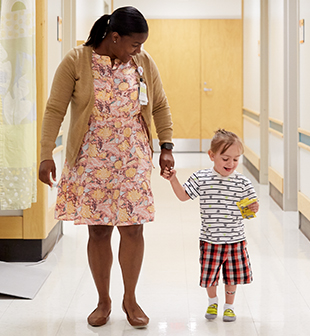New Strategies Minimize Barriers to Kidney Transplant
 “Fast” is not a word anyone would associate with the experience of waiting for a kidney transplant. Despite certain factors beyond a care team’s control, however, much can be done to minimize unnecessary delays. In 2018, pediatric nephrologists at Cincinnati Children’s led efforts to streamline the process — and find the best possible donor kidney for every patient.
“Fast” is not a word anyone would associate with the experience of waiting for a kidney transplant. Despite certain factors beyond a care team’s control, however, much can be done to minimize unnecessary delays. In 2018, pediatric nephrologists at Cincinnati Children’s led efforts to streamline the process — and find the best possible donor kidney for every patient.
Some improvements focused on reducing the amount of time that passed between receiving a patient referral and conducting the committee review. “Many patients referred to us for a transplant evaluation are on dialysis, and it’s critical to get them to our review committee as quickly as possible,” says David Hooper, MD, medical director for the Kidney Transplant Program. “Previously, our transplant coordinators were responsible for scheduling all the tests and other evaluations required for the committee review. This complicated process could take hundreds of days.”
The team partnered with Clinical Concierge Services, a group within the hospital that specializes in scheduling complex hospital visits. Now, clinical concierges schedule almost all tests, procedures and physician visits. That small change reduced the referral-to-review process to 90 days or less; many cases are presented to committee within 30 days. Kidney transplant coordinators are still a family’s main point of contact, but now can focus on clinical and psychosocial concerns, rather than on scheduling.
Expanding the donor kidney pool
Once on the kidney transplant waiting list, families face the reality of scarce donor kidney supply. Hooper and colleagues are finding new ways to address that, too.
For example, the hospital recently partnered with the National Kidney Registry to offer paired kidney exchanges, which allow swaps when a living donor and the intended recipient are not compatible for transplant. Paired exchanges can mean shorter wait times, and more opportunities to find an optimal match.
Since Cincinnati Children’s began offering kidney transplants in 1965, more than half of its 688 kidney transplant surgeries have involved living donors. Highly skilled pediatric transplant surgeons perform donor nephrectomies in an operating room located next door to the OR where the living kidney transplant will take place. This simplifies scheduling and surgical coordination, and means less storage time for the donated organ compared to surgeries when the nephrectomy takes place at a second institution.
Improving patient access
After transplant, patients transition to outpatient follow-up, where a new concept at Cincinnati Children’s called “Team Kidney” has improved access and overall satisfaction. The team includes pediatric nephrologists, experienced, highly trained kidney transplant coordinators and a pharmacist specializing in kidney transplantation, in addition to a dedicated psychologist, social worker and dietician. These individuals meet frequently to discuss each patient. “At each visit patients see the same kidney transplant coordinator and other members of the transplant team,” Hooper says. “This team approach allows us to address all needs of our patients in a comprehensive fashion, while still providing continuity, more flexibility in scheduling clinic appointments and better access for our patients.”

